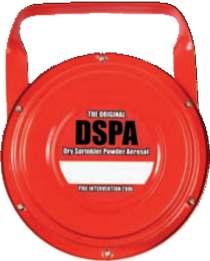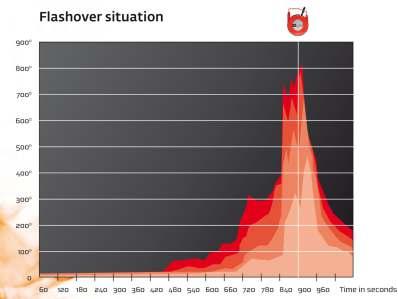
4 minute read
Is DSPA the Answer to your Knock Down Meeds?
Is DSPA the Answer to your Knockdown Needs?
Aerosol generators have been around for some time, but the relatively new DSPA-5 knockdown tool could be the solution to a variety of issues currently being faced by various fire and rescue services in India, including: high rise apartment blocks; reducing water damage; safer working conditions for firefighters. First introduced at an open demonstration hosted by Pune Fire department in 2012, the DSPA-5 is being closely monitored by a number of fire and rescue services in India, with Steel Authority India Ltd Fire Service the latest brigade to test it at their Fire Training Unit. The DSPA-5 is a hand held, grenade-like device that is activated manually by a sharp tug on the detonator. The firefighter then has around eight seconds to throw the device towards the seat of the fire, either through an open door or window. There is no need for the firefighter to enter the structure. This activation converts the solid material in the canister into an aerosol that floods the compartment. The compound consists mainly of potassium-based particles, which are non-toxic, non-conductive and non-corrosive. They are harmless to humans and animals and environmentally friendly; so there are no issues with clearing away afterwards and disposing of the used canisters. Any subsequent fire investigation is not compromised. The compound acts by interrupting the chemical reaction that causes the flames. By removing the flames the temperature in the compartment is dramatically reduced, so making it safer for the firefighters to enter the structure to attack the fire. On the
Advertisement
After the pin is removed from the starter, the device will make a clicking sound. The DSPA-5 is now activated and will start producing aerosol after a delay of 6 to 8 seconds. The DSPA-5 will produce all its aerosol within 40 seconds. Always throw the DSPA5 directly inside the room without any hesitation! Keep downside, however, is the lack of visibility once the DSPA-5 has been activated. This can be overcome by the use of thermal imaging cameras. Trained fire fighters and first responders need to evaluate and judge the situation carefully before deciding if the DSPA-5 can be deployed. If a room is properly closed (preventing aerosol loss), the more effective the DSPA-5 will be.
Activation of the DSPA-5 has been made very simple for any fire person to use it. :
Bend the far ends of the pins straight, like displayed down below:
a safe distance considering the temperature build up around the DSPA-5. Close the room immediately after deployment. Frans Vogelzangs, CEO of DSPA b.v., the Netherlands manufacturer for the DSPA products, explains,
“At the test at Cheshire's headquarters, a fire attack container was loaded with a crib filled with wood, then two walls and the ceiling lined with plywood. The crib was lit and the fire allowed to develop to over 700°C. A DSPA-5 was deployed and left to do its work for approximately 45 seconds. “With the aid of their thermal imaging camera the crew then approached the container to attack the fire. Once in the compartment it was noticeable that the temperature had reduced considerably and, with the aid of the camera, they could locate and fully extinguish the remaining hotspots. Very little water was required.” The nature of the aerosol generator restricts the type of fires for which it is appropriate. “We see the DSPA-5 as being a valuable tool for attacking fires in compartments such as basements and high rise residential blocks,” says Frans. "The independent report from Chiltern highlighted the manner in which the DSPA compound contained the fire spread so buying valuable time for the firefighters. In various parts across India, they have a real problem with accessing water in the rural areas, so they see the DSPA-5 as a valuable tool to enable them to utilise the water much more efficiently and effectively,” says Frans. "We also see the unit as a potential defence against fires on sites where there are extremely narrow lanes thus restricting the movement of fire vehicles at the scene of fire. For these situations DSPA-5 knockdown tool can be extremely effective. The best part is it is additive in nature so you can deploy multiple units into the fire and it will do the job” DSPA-5 demonstrations were recently carried out for the Indian railways. Frans says, "We are delighted to have partnered with various reputed distributors throughout India for the distribution of the DSPA-5 device. They have a proven track record in supplying to the various fire and rescue services pan India and the DSPA-5 fits in with their product portfolio.” In general, one DSPA-5 can be used to fight fires in rooms of which the size is depending on unit of choice considering there are no big (ventilation) holes or openings. After activation, the aerosol will be released within 6-8 seconds. In a properly sealed room, the aerosol stays airborne for a considerable amount of time (up to 30 mins). As time progresses, the aerosol particles will slowly precipitate or disappear through small cracks and holes. The speed in which this happens, depends on the size and quantity of these openings.

When fighting fully developed fires, which can result in flashovers or backdrafts, DSPA-5 will knock down the flames and drop the temperature quickly and efficiently to a manageable level. For firefighters this means that the safety when performing an indoor attack will be increased significantly.










